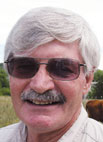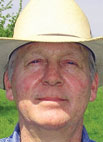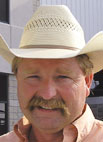
In Christian County, near Oldfield, Mo., David and Connie Krider are raising a different breed of cattle. On their 220-acre farm, they are crossing South Poll and Tuli cattle. David said, “There are so few Tuli cattle in the United States. This is the only South Poll/Tuli cross that I’m aware of.”
He has had South Polls for about two years and Tuli cattle for about a year and a half. He stated, “This is our first calf crop. We bought the South Polls as heifers.”
South Poll is a breed developed in the United States by Teddy Gentry, of Alabama. David explained, “He (Teddy) was looking for a breed of cattle that would do well in the hot, humid south.” David said the attributes that make the South Poll breed stand out are, “their fertility, heat resistance and doing well on grass.” He added, “An animal that does well with forage in front of it doesn’t need a lot of supplementing. That’s usually true with moderate-framed animals.”
He explained that Teddy Gentry wanted to develop a breed that was, “heat resistant, insect resistant and maintained fertility. High heat is kind of adverse to high fertility, so he wanted a cow that would perform better.”
“South Poll is getting to be a very popular breed. It’s a moderate size cow,” David said. He explained, “Generally, if you’re looking at animals that do well in very hot conditions, you’re usually finding a small to medium size animal.”
David is always looking for cattle that are more, “maintenance free; more natural.” A familiar saying in the cattle industry is, “your cattle should be working for you.” David is a firm believer in that philosophy. He stated, “If you’re out there hauling feed to your cattle, if they’re waiting at the fence for you to bring more feed, there’s something wrong with this picture.”
David is president of Powerflex Fence, a fencing and water supply company located in Seymour, Mo. He explained how his business and farming go hand in hand. He said, “We’re not doing it (breeding cattle) on a large enough scale to be a commercial operation, but it ties in with our main business which is fencing, water systems and livestock grazing. So along with testing fencing and water systems, we also like to develop different genetics that do very well on grass.”
He wanted to try the Tuli breed because, “everything we read about the Tuli fit into what we were looking for.”
David explained that Tuli is a breed developed in Africa. He said, “They were brought into the United States 15 to 20 years ago to Texas A&M. They did studies on the Tuli breed for about five years, on fertility, heat resistance and parasite resistance to see how they did in the southern climate.” After five years they released some into the market. He stated, “We’ve got the first group of calves on the ground that are South Poll/Tuli crosses.”







